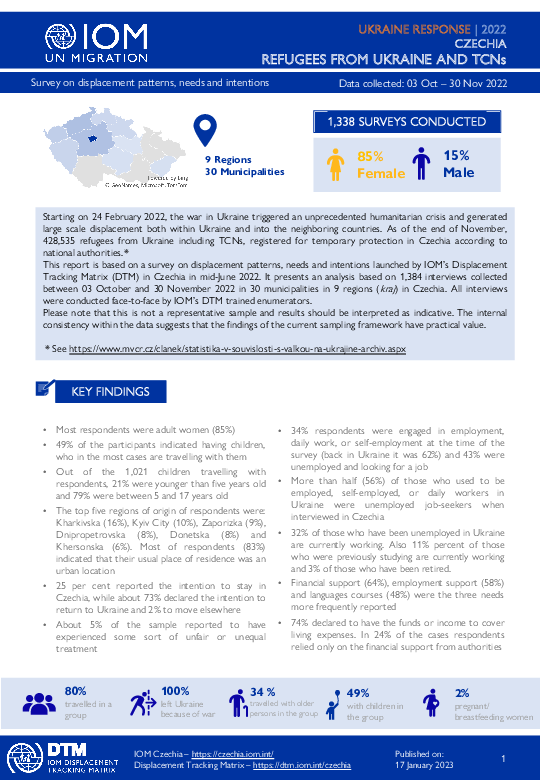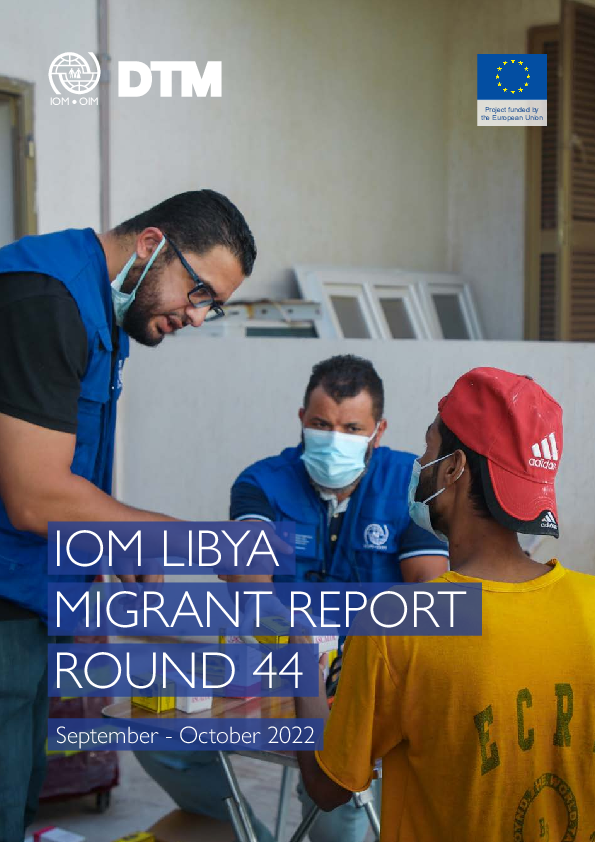-
Countries
-
Data and Analysis
-
Special Focus
-
Crisis Responses

Contact
DTM Mauritania, DTMMauritania@iom.int
Language
French
Location
Mauritania
Period Covered
Nov 01 2022
Nov 30 2022
Activity
- Survey
- Flow Monitoring
La transhumance est une pratique de longue date en Mauritanie où elle a évolué au cours des dernières décennies telles que la raréfaction des ressources impliquant la redéfinition des routes empruntées par les troupeaux. Par conséquent, des conflits peuvent survenir lorsque les agriculteurs et les éleveurs transhumants. Dans le cadre du Suivi des Mouvements de Transhumance, l’OIM met en œuvre un système d’alerte qui a pour objectif de recenser les mouvements inattendus de bétail et les conflits ou catastrophes naturelles liés à l’utilisation des ressources naturelles et aux interactions entre agriculteurs et éleveurs, de comprendre les modes de résolution de conflits existants et d’informer les autorités compétentes, dans l’objectif de réduire les tensions dans les régions d’intervention. Ce tableau de bord présente les informations fournies par le biais de 21 informateurs clés, présents dans huit régions (Assaba, Brakna, Gorgol, Guidimakha, Hodh El Chargui, Hodh El Gharbi, Tagant et Trarza) pendant le mois de Novembre 2022.

Contact
DTM Mauritania, DTMMauritania@iom.int
Language
English
Location
Mauritania
Period Covered
Oct 01 2022
Oct 30 2022
Activity
- Survey
- Flow Monitoring Survey
- Flow Monitoring
La transhumance est une pratique de longue date en Mauritanie où elle a évolué au cours des dernières décennies telles que la raréfaction des ressources impliquant la redéfinition des routes empruntées par les troupeaux. Par conséquent, des conflits peuvent survenir lorsque les agriculteurs et les éleveurs transhumants. Dans le cadre du Suivi des Mouvements de Transhumance, l’OIM met en œuvre un système d’alerte qui a pour objectif de recenser les mouvements inattendus de bétail et les conflits ou catastrophes naturelles liés à l’utilisation des ressources naturelles et aux interactions entre agriculteurs et éleveurs, de comprendre les modes de résolution de conflits existants et d’informer les autorités compétentes, dans l’objectif de réduire les tensions dans les régions d’intervention. Ce tableau de bord présente les informations fournies par le biais de 21 informateurs clés, présents dans huit régions (Assaba, Brakna, Gorgol, Guidimakha, Hodh El Chargui, Hodh El Gharbi, Tagant et Trarza) pendant le mois de Octobre 2022.

Contact
DTMcovid19@iom.int
Language
English
Location
Global
Period Covered
Mar 10 2020
Dec 19 2022
Activity
- Other
The DTM Global Mobility Restrictions Overview began documenting how international air travel restrictions and conditions for authorized entry evolved as of March 2020 when COVID-19 was declared a global pandemic. Using IATA Timatic Coronavirus Outbreak Updates, DTM has documented how each country, territory or area (C/T/A) changed its entry restrictions in line with public health-related immigration and border management measures. Data was collected from 229 C/T/As (Arrival C/T/A) showing the different types of travel measures and accompanying exceptions placed on a total of 247 C/T/As (Restricted CTAs). As the situation evolved, DTM data collection showed emerging trends in the post COVID-19 mobility restrictions and conditions for entry. The Global Mobility Restrictions Overview has provided information intended to support IOM missions and partners in targeted response planning and advocacy for vulnerable populations who may have been affected by changes in global mobility. Since the onset of the COVID-19 pandemic, C/T/As responded to rising infection rates with a series of measures restricting global mobility.
These ranged from entry restrictions (passenger bans on travellers arriving from specific C/T/As and flight suspensions) to a series of conditions for authorized entry which individual passengers had to meet in order to enter a C/T/A by air travel. These conditions included medical measures (COVID-19 test and/or vaccination certificates, quarantine and other health-related requirements) as well as changes to visa/other documentation requirements and passenger registration and tracking tools monitoring arrivals after entry. Data was also collected on the accompanying exceptions that made certain groups of individuals exempt from travel measures (for example, nationals and residents or children under 18 years old). Most recently, since April 2022, entry restrictions and conditions for authorized entry have gradually been lifted and air travel has become less restricted.
Throughout the development of the COVID-19 pandemic, governments have had varying responses to the virus spread either through trying to contain it, delay its arrival or minimize the number of infections overall (MPI, 2022). As restrictive travel measures due to COVID-19 have progressively declined globally, DTM is ending its data collection on COVID-19 mobility impacts. This final report details the most significant events and the regional and global trends on the issuing of entry restrictions, conditions for authorized entry and the respective exception groups that shaped COVID-19’s impact on global mobility.
Contact
DTMUkraine@iom.int
Location
Ukraine
Activity
- Mobility Tracking
- Baseline Assessment
Period Covered
Dec 12 2022 -Dec 25 2022
A baseline assessment is a sub-component of mobility tracking. It aims to collect data on IDP, migrant or returnee population presence in a defined administrative area of the country.
A more detailed version of this dataset is available, to get access kindly click on the 'Request Access' button
Population Groups
Survey Methodology
Unit of Analysis Or Observation
Type of Survey or Assessment
Keywords
Geographical Scope
Administrative boundaries with available data
The current dataset covers the following administrative boundaries

Contact
DTMUkraine@iom.int
Language
English
Location
Ukraine
Period Covered
Dec 12 2022
Dec 25 2022
Activity
- Baseline Assessment
The IDP Area Baseline assessment provides granular data on the number and geographic location of officially registered internally displaced persons (IDPs). Data collection for the Area Baseline assessment Round 19 took place between 12 and 25 December across 22 oblasts and Kyiv city. Since last round, DTM has expanded its geographical coverage by collecting the IDP figures from local authorities in Donestka oblast. In the areas covered, the number of recorded IDPs was collected for all 111 raions and 940 hromadas (71 per cent of all hromadas in the covered oblasts). In addition, gender disaggregated figures were provided across 52 per cent of hromadas – in those areas, 62 per cent of registered IDPs were females and 398 per cent were males in assessed locations.
This report assesses registered IDP presence at the hromada and oblast-levels, while also mapping the percentage change since the previous round. It further highlights the rate of change at the macro-regional level and charts the registered IDP figures at the raion-level across the previous 8 rounds.
Contact
DTMUkraine@iom.int
Location
Ukraine
Activity
- Mobility Tracking
- Baseline Assessment
Period Covered
Dec 12 2022 -Dec 25 2022
A baseline assessment is a sub-component of mobility tracking. It aims to collect data on IDP, migrant or returnee population presence in a defined administrative area of the country.
Population Groups
Survey Methodology
Unit of Analysis Or Observation
Type of Survey or Assessment
Keywords
Geographical Scope
Administrative boundaries with available data
The current dataset covers the following administrative boundaries

Contact
DTM Europe, DTMMediterranean@iom.int
Language
English
Location
Czechia
Period Covered
Oct 03 2022
Nov 30 2022
Activity
- Survey
- Flow Monitoring
Starting on 24 February 2022, the war in Ukraine triggered an unprecedented humanitarian crisis and generated large scale displacement both within Ukraine and into the neighboring countries. As of the end of November, 428,535 refugees from Ukraine including TCNs, registered for temporary protection in Czechia according to national authorities.* This report is based on a survey on displacement patterns, needs and intentions launched by IOM’s Displacement Tracking Matrix (DTM) in Czechia in mid-June 2022. It presents an analysis based on 1,384 interviews collected between 03 October and 30 November 2022 in 30 municipalities in 9 regions (kraj) in Czechia. All interviews were conducted face-to-face by IOM’s DTM trained enumerators
Contact
DTM Burundi, DTMBurundi@iom.int
Location
Burundi
Activity
- Mobility Tracking
- Event Tracking
Period Covered
Jan 08 2023 -Jan 14 2023
Activated on an ad hoc basis, the DTM Emergency Tracking provides early field reports at the beginning of a complex crisis, allowing IOM to gather, consolidate and disseminate baseline information on displacement and return figures at the onset of a newly emerging crisis. The DTM Emergency Tracking relies heavily on information provided by RARTs or partners within the humanitarian community about an unfolding situation. The Emergency Tracking gathers data through IOM Burundi’s extended network of key informants, who provide basic information on the new displacement, be it of IDPs or returnees, or both, including numbers, location and shelter types. While IOM DTM strives to provide best estimates, the Emergency Tracking aims to be a quick monitoring tool with real-time data turnover ranging from 24 to 72 hours following its activation.
Population Groups
Survey Methodology
Unit of Analysis Or Observation
Type of Survey or Assessment
Keywords
Geographical Scope
Administrative boundaries with available data
The current dataset covers the following administrative boundaries

Contact
DTM Libya, DTMLibya@iom.int
Language
English
Location
Libya
Period Covered
Sep 01 2022
Oct 31 2022
Activity
- Mobility Tracking
- Baseline Assessment
IOM Libya’s Displacement Tracking Matrix (DTM) programme identified a total of 683,813 migrants from over 42 nationalities in the 100 Libyan municipalities during Round 44 of data collection (September - October 2022). The number of migrants in Libya has continued to increase slightly compared to the previous reporting period (679,974 migrants, Round 43, July – August 2022) in line with a trend that started at the beginning of 2021. Prior to 2021 the number of migrants in Libya had been declining following the COVID-19 pandemic in 2020. The number of migrants in Libya identified during Round 44 is also higher than the number of migrants for the corresponding period in 2019 (654,081 migrants, Round 28, October - November 2019).

Contact
DTM Libya, DTMLibya@iom.int
Language
English
Location
Libya
Period Covered
Sep 01 2022
Oct 31 2022
Activity
- Flow Monitoring
- Mobility Tracking
- Baseline Assessment
This infographic presents the key findings of Round 44 of the mobility tracking component of the Displacement Tracking Matrix (DTM) programme in Libya.